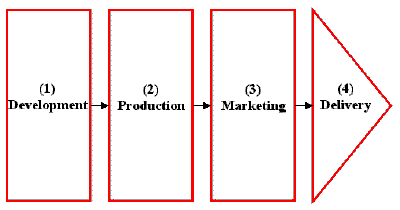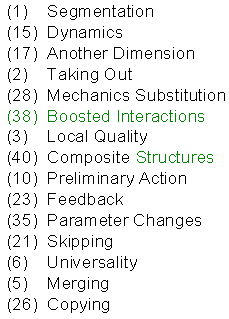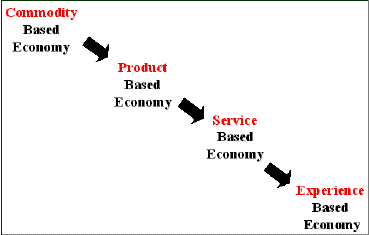
Darrell MANN
Industrial Fellow, Department Of Mechanical Engineering
University Of Bath, Bath, BA2 7AY, UK
+44 (1225) 826465 FAX +44 (1225) 826928
D.L.Mann@bath.ac.uk
Ellen DOMB
The PQR Group, 190 N. Mountain Ave., Upland, CA 91786 USA
+1(909)949-0857 FAX +1(909)949-2968
EllenDomb@compuserve.com
INTRODUCTION
This article is the first in what will be a series of articles examining connections between TRIZ and the solution of problems involving contradictions found in the business world.
Here we will be looking at the work of B Joseph Pine II, and his discoveries surrounding the widespread business trend towards ‘mass customization’ (1). This apparently paradoxical term - relating to a need for organizations to create large output of individual product solutions - implies a potential for considerable commonality with the Contradiction solving methods and strategies found in TRIZ.
The article aims to answer three key questions:-
Beyond these questions, a final section of the article will examine the Mass Customization phenomenon in relation to a generic pattern of business evolution trends, and establish possible connections with Altshuller’s discoveries concerning evolution of technical systems.
MASS CUSTOMIZATION
Mass Customization is all about the (economically viable) mass production of individually customized goods and services. In his book, Joe Pine describes five basic methods by which organizations can achieve mass customization:-
Pine also discusses four innovations which further help to eliminate the ‘mass’ and ‘customized’ contradiction within an organization:-
Each of the methods and innovations apply to different stages in what Pine describes as the key links in an organization’s value chain (Figure 1):

Let us look at each of the methods and innovations from the perspective of their possible connection to TRIZ Inventive Principles.
|
Mass Customization Principle |
Example |
Equivalent TRIZ Inventive Principles |
|
Customization of services around standardized products and services (3, 4) - step number in value chain |
IBM System/360 Marriott hotel chains Flexible travel packages |
(1) Segmentation |
|
Customizable products and services (1, 3) |
Gillette Sensor razor Reebok Pump shoes Adjustable office furniture |
(6) Universality |
|
‘Point of delivery’ customization (3, 2 added to 4) |
Dealer-fit car accessories Lenscrafters/Eyelab/etc 1 hour photo-processing |
(10) Preliminary Action |
|
High responsiveness throughout the value chain (1, 2, 3, 4) |
Benetton Peerless Saw Company Levi Strauss Nissan ‘3 Day Car’ |
(15) Dynamics |
|
Modularization of components (1, 2, 3, 4) |
Lutron Electronics Black & Decker Getaway Vacations |
(5) Merging |
|
Just-in-time (JIT) delivery |
Numerous horizontally integrated industries - e.g. automotive |
(20) Continuity of Useful Action |
|
Reduction of set-up and change-over times |
Flexible Manufacturing Systems |
(10) Preliminary Action |
|
Reduction of cycle times throughout the value chain |
Most ‘continuous improvement’ initiatives |
(15) Dynamics Local Quality |
|
Production based on orders not forecasts |
Nissan ‘3 Day Car’ |
(19) Periodic Action |
While concentrating only on the ‘most likely’ Inventive Principles (as opposed to ‘all’) in each case, it is clear that all of the techniques required to achieve ‘Mass Customization’ are to be found within the current set of Inventive Principles.
A TRIZ PERSPECTIVE
Having been derived specifically for use in solving technical problems, the 39 generic parameters which make up the Matrix will, likely as not, require considerable modification in order to be relevant to business-type problems. This modification looks set to require a fairly long and arduous period of research effort. In the meantime, however, ‘Mass Customization’ offers a contradiction which does appear to fit quite elegantly into the existing Matrix structure.
In TRIZ terms, then, ‘Mass Customization’ involves the search to improve the ADAPTABILITY & VERSATILITY of a product or service to suit the needs of a particular individual. As adaptability and versatility are improved, PRODUCTIVITY tends to get worse - i.e. as manufacture quantities tend towards one, it becomes progressively more difficult to achieve economically viable production.
According to the Contradiction Matrix, inventors working with technical problems have most commonly used the following Inventive Principles to solve ADAPTABILITY & VERSATILITY versus PRODUCTIVITY problems:-
(35) Parameter Changes
(28) Mechanics Substitution
(6) Universality
(37) Thermal Expansion
The list bears only occasional resemblance to the table of Inventive Principles suggested from Pine’s work. ‘Parameter Changes’ (or rather the ‘change consistency’ or ‘change degree of flexibility’ parts of Parameter Changes) is used quite frequently, ‘Universality’ once, and ‘Mechanics Substitution’ and ‘Thermal Expansion’ not at all.
The discrepancy between current Matrix suggestions and the suggestions made in the Mass Customization text, suggests that a ‘Business Contradiction Matrix’ will be markedly different to the current Matrix, at least in terms of this one contradiction.
On the other hand, it is perhaps worthwhile in examining whether the Inventive Principles suggested by the current Matrix have anything of value to offer to the Mass Customization problem:
Mechanics Substitution - as interpreted in Reference 3, the idea of replacing a mechanical entity with sensory means or a field, potentially has much to offer organisations interested in shifting to a Mass Customized method of doing business. At the most basic level, this is so because replacement of a physical entity with a sensory or field alternative means implies significant reductions in manufacture cost.
At a more detailed level, we might see the inbuilt user customizability of commercial word-processing software packages as an example of how substitution of a hard-wired system for user specifiable settings built into (no physical cost) software is an excellent means of achieving economically viable, mass-customized products. Similarly with the shift from mechanical to electronic based camera systems; let the software allow the customer to customize the camera operation to their own personal requirements.
Looking at ‘fields’ from the manufacturer perspective, as in Pine’s Levi Strauss case study, laser and ultrasonic measurement systems are much faster, more accurate, and measure a variety of parameters simultaneously, and return their results in digital form, relative to traditional mechanical methods of measuring. This makes mass customization of products such as clothing and contact lenses much faster and less expensive than traditional methods.
Mechanics Substitution may thus be seen to have much to offer in the context of Mass Customization.
Thermal Expansion - was interpreted in Reference 3 primarily as increasing the ‘excitation’ (heat) of people in an organisation. In this sense, there is a degree of overlap with the ‘Boosted Interactions’ Inventive Principle - which was shown in Pine’s book to be an important factor in achieving Mass Customization through high responsiveness through the value chain. The ‘differential expansion’ element of the Thermal Expansion Principle, perhaps suggests that the desired high responsiveness might be improved through due consideration of personality matching of the different individuals in the different parts of the chain.
Either way, Thermal Expansion is unlikely to feature in any ‘top 5’ Inventive Principles relevant to the achievement of effective Mass Customization.
While in all probability possible to make connections between every one of the Inventive Principles and the Mass Customization contradiction, based on Pine’s book, and the work described here, the Principles most likely to be beneficial in a Mass Customization context are felt to be, in approximate order of descending importance:-

RELATION TO TRENDS OF EVOLUTION
The Mass Customization phenomenon is consistent with several of the TRIZ trends of evolution. In fact, it is possible to see direct connections with just about all of the trends (Introduction of additives - user customizable features, Rhythm Co-ordination - systems which adapt to the way in which individual users utilise the product, Space Segmentation - evolution to active/adaptive pores, etc). We will concentrate here on just a few:-Ideality - The trend towards increasing ideality (=benefits/(costs + harm)) is universal. Successful Mass Customization requires the recognition that different customers have different requirements; and that the benefits, costs and penalties for one may thus be completely different for another. The most significant change from traditional TRIZ practice is to shift the evaluation from the point of view of the manufacturer to the point of view of the customer.
|
Ideality Element |
Traditional TRIZ: the manufacturer’s view |
Mass Customization: the individual customer’s view |
|
Benefits |
What the typical customer wants |
What I want, at the time that I want it |
|
Cost |
Materials, labor, design, distribution, packaging, sales, etc. |
Costs to purchase, operate, maintain, and dispose of. |
|
Harm |
Undesirable side effects, legal liabilities, social impact |
Undesirable features (Could be seen as benefits at a different time!) Time to learn to use it. Undesirable side effects, legal liabilities, social impact. |
Thus, Customer X’s vision of the ideal video recorder as one which can be set to record a dozen different programmes, water the plants and feed the cat, is Customer Y’s vision of an expensive product requiring a rocket-science degree to operate. The designer and manufacturer have the challenge of creating either one product where the complexity is hidden from Customer Y, and is inexpensive enough that she will still buy the product, or creating two products, where one is capable of all that Customer X wants and the other is limited to only what Customer Y wants. This sets up a physical contradiction, generally described in TRIZ as “I want A but I want ‘not A’ “ which is solved at the general level by separation principles and at the operational level by the 40 principles. (We will return to the solving of physical contradictions in the business context in a future article.)
A successful Mass Customization shift is thus crucially dependent on the ability to first tap into the different customer views on benefit, cost and harm, and second to then translate that knowledge into products that can satisfy all the demands.
Transition from macro to micro level - while the increasing division of physical entities into smaller and smaller components is highly analogous to the idea of Mass Customization being focused on ever smaller customer groups, it is also worth noting that the TRIZ trend progresses beyond the small scale object through to powders, liquids, gas and ultimately fields. Whilst perhaps not immediately obvious in the context of ‘customers’ rather than ‘things’, the trend does continue to be applicable (and highly relevant) if an analogy is drawn between ‘fields’ and customer ‘perceptions’ and ‘moods’.
A good example here comes from a recently opened London hotel. Recognising that not only do different occupants have different preferences as regards, say, the colour of the room they are staying in, but also that the same occupant might have different desires depending on the time of day (i.e. different moods), they have configured lighting and décor systems which allow customers to modify the apparent colour of the room at the flick of a switch.Mono-Bi-Poly - the combination of similar and dis-similar objects into ‘combined polysystems’ is again highly consistent with the idea of mass customized goods: Lots of different elements combined into a system means increased likelihood that at least one will suit the particular requirements of a given individual customer.
The problem here is the common ‘how poly is poly’ issue, or, how far along the poly evolution path is it possible to go before the increased functionality benefits begin to be out-weighed by the increased costs and harms? Although there is no simple answer to this question, it appears clear - when thinking about mass customization through product modularization - that, at the very least, ‘combined polysystems’ need to incorporate the potential for additional components/functions to be added - e.g. cameras, modular hi-fi systems, dealer/user fit car accessories, etc.
Another Perspective
Following on from this activity, we set out to look at whether Joe Pine’s work had anything to add to the TRIZ trends of evolution. The initial answer - as shown in Figure 2 derived from Reference 6 - is that, yes it does. Integration of the economic evolution from Commodity to Product to Service to Experience based economic regimes with the technical trends of evolution then appears to offer considerable business performance benefit potential. That will be the subject of a future article.

Figure 2: Global Economy Evolution Trend (based on Reference 6)
CONCLUSIONS
This article set out to answer three main questions:-
A study of business evolution trends has shown that Mass Customization is highly consistent with and complementary to established TRIZ trends of technology evolution.
Mass Customization looks set to become a dominant business trend across many industry sectors. TRIZ may be expected to play a significant role in helping organizations to effectively and creatively enter or expand the Mass Customized marketplace.
REFERENCES